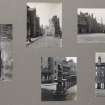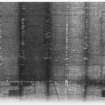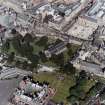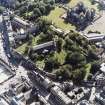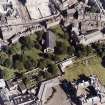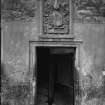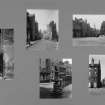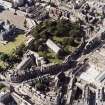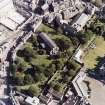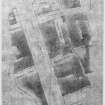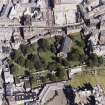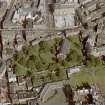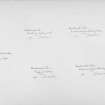Edinburgh, 36, 38, 40 Candlemaker Row, Candlemakers' Hall
Hall (18th Century), Tenement(S) (18th Century)
Site Name Edinburgh, 36, 38, 40 Candlemaker Row, Candlemakers' Hall
Classification Hall (18th Century), Tenement(S) (18th Century)
Canmore ID 52399
Site Number NT27SE 356
NGR NT 25677 73296
Datum OSGB36 - NGR
Permalink http://canmore.org.uk/site/52399
- Council Edinburgh, City Of
- Parish Edinburgh (Edinburgh, City Of)
- Former Region Lothian
- Former District City Of Edinburgh
- Former County Midlothian
NT27SE 356 25677 73296
No. 36, built by James Watson in 1722, contains the former hall of the Incorporation of Candlemakers. Restored in 1929 by E J MacRae, together with the adjoining Nos. 40-42, originally two 17th-century tenements (Henry's Land and Binny of Nisbet's Land) bought by the Candlemakers in 1733-4 and altered by them soon after.
W F Gray 1930; RCAHMS 1951; J Gifford, C McWilliam and D Walker 1984.
Candlemaker Hall -fine four-storeyed block with two square stair towers projecting to the street. Over the door of one is a defaced panel containing a shield and the date 1722. This house was reconstructed by the City in 1929.
REFERENCE: CITY ARCHITECTS' PLAN STORE
Various plans.
Publication Account (1951)
55. The Candlemakers' Hall, etc., 36 Candlemaker Row.
By the beginning of the 16th century candlemaking had already become a specialised industry in Edinburgh. The craftsmen who engaged in it were incorporated some time before 1517, and their Incorporation flourished, although it had no civic status, until the introduction of gas lighting in the first decades of the 19th century. Being generally regarded as undesirable neighbours on account of the nuisance caused by the melting tallow, the craftsmen were forbidden by the Town Council to have their workshops on the main thoroughfares; and in 1654, when a candlemaker's workshop in Forrester's Wynd took fire, the Town Council recommended that the craft should be segregated, on account of this risk. Ultimately, however, it was granted the use of certain waste ground near the Society Port in the Flodden Wall, to the E. of Greyfriars Churchyard, for its workshops, and it accordingly settled in that neighbourhood. In 1722 the Candlemakers began to build the tenement that contained their Convening Hall, their “Boxmaster”, William Braidwood, entering into a contract with James Watson, late Deacon of the Masons' Incorporation, for its construction at a cost of £200, the necessary material to be supplied by the Boxmaster. (1)
This tenement is still extant as No. 36 Candlemaker Row, the S. unit of an almost identical pair standing at the head of Candlemaker Row. Oblong on plan but for a rectangular stair-tower, which projects towards the street from the S. end, it is four storeys in height and is built of rubble. The moulded entrance to the staircase is surmounted by a weatherworn panel, containing a shield, with helm and mantling, above a scrolled cartouche. The date 1722 is incised upon the lower margin, and the arms of the Incorporation, with their motto “Omnia manifesta luce”, are said to have once been visible. The lowest floor is entered from the street. Each floor above was a separate flat, while the Convening Hall occupied the top storey. This Hall, the only internal part of the building that is of interest, is a square, pine-panelled "throughroom," with a plaster ceiling on which traces of painted decorations were formerly visible. It is lit by large windows on each side, two facing the street and two others looking into the churchyard behind. High up on the walls are fixed a series of twelve panels recording "mortifications" made between 1685 to 1798; all the inscriptions were apparently lettered at about the same time, some on the top of older ones. This tenement has recently been restored by the Town Council.
The adjoining tenement, No. 40 Candlemaker Row, formerly known as Henry's Land, is partly earlier and partly later than its neighbour, for its two lower storeys were already in existence in 1722 while the two upper ones and the staircase, which is almost central, were added some time after the Convening Hall was built.
RCAHMS 1951
(1) O.E.C., xvii, pp. 91-146.
Project (1997)
The Public Monuments and Sculpture Association (http://www.pmsa.org.uk/) set up a National Recording Project in 1997 with the aim of making a survey of public monuments and sculpture in Britain ranging from medieval monuments to the most contemporary works. Information from the Edinburgh project was added to the RCAHMS database in October 2010 and again in 2012.
The PMSA (Public Monuments and Sculpture Association) Edinburgh Sculpture Project has been supported by Eastern Photocolour, Edinburgh College of Art, the Edinburgh World Heritage Trust, Historic Scotland, the Hope Scott Trust, The Old Edinburgh Club, the Pilgrim Trust, the RCAHMS, and the Scottish Archive Network.
Field Visit (30 July 1999)
Badly eroded relief composed of a central light source (candle? Christ figure?) with horizontal radiating lines. Some suggestion of torso?, bulk below. Sign area at bottom surrounded by eight scrolls.
Inscriptions : On bottom frame (incised numbers): 1722
Painted below relief in gold letters on blue:
CANDLE[ ]
Signatures : None Visible
Design period : 1722 (1)
Information from Public Monuments and Sculpture Association (PMSA Work Ref : EDIN0112)







![Scanned image of IGL W718/3/10 [negative number to be supplied].](http://i.rcahms.gov.uk/canmore/l/SC00842599.jpg)



![Scanned image of IGL W718/3/11 [negative number to be supplied].](http://i.rcahms.gov.uk/canmore/l/SC00842600.jpg)
















![Scanned image of IGL W718/3/10 [negative number to be supplied].](http://i.rcahms.gov.uk/canmore/s/SC00842599.jpg)


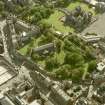
![Scanned image of IGL W718/3/11 [negative number to be supplied].](http://i.rcahms.gov.uk/canmore/s/SC00842600.jpg)
